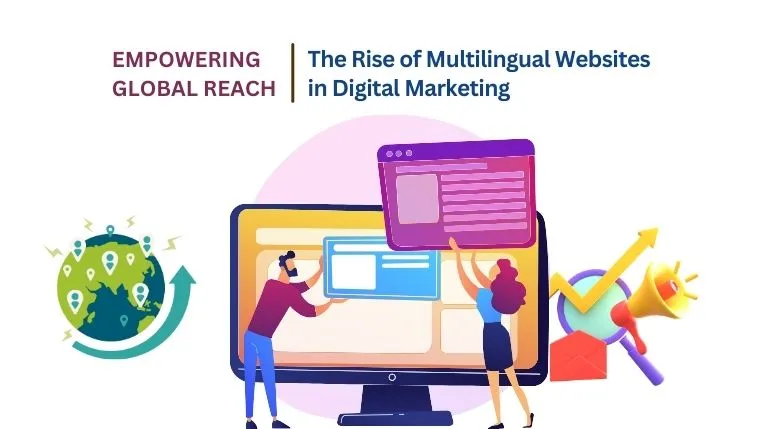 Did you know that over 75% of internet users prefer to purchase products in their native language, and 72% of consumers spend most or all of their time on websites in their preferred language?
Did you know that over 75% of internet users prefer to purchase products in their native language, and 72% of consumers spend most or all of their time on websites in their preferred language?
The global markets are shrinking due to globalization, and companies are realizing the importance of reaching diverse audiences in their native languages. This is where multi-language website translation comes into play. Let’s read its importance in the blog.
1. The Growing Need of Multilingual Websites
Several factors drive the growing need for multilingual websites:
- The internet has generated a global marketplace where consumers from different countries and cultures can interact with brands.
- As eCommerce grows, companies increasingly target international markets to sustain growth.
- Providing content in multiple languages enhances customer trust and satisfaction, which are key brand loyalty drivers.
2. Benefits of Multilingual Websites in Digital Marketing
Enhanced Customer Experience
One of the most significant benefits of having a multilingual website is the ability to provide a personalized and relevant experience for each visitor. When customers can explore websites, read product descriptions, and receive customer support in their preferred language, they feel more comfortable and understood. This level of personalization enhances customer experience, making visitors more likely to stay longer on the site, interact with the content, and convert into customers. This highlights why there is a need for website translation services in multiple languages, as it directly impacts customer satisfaction and business success.
Expand Your Market Reach and Drive Revenue with Multilingual Sites!
Start reaching a global audience and increase your sales
Boost in SEO and Online Visibility
Search engine optimization (SEO) is an essential part of digital marketing, and a multilingual website can significantly boost SEO efforts. Organizations can rank for a broader range of keywords and appear in search results for users who search in different languages by translating the content into several languages. This expanded reach increases online visibility and drives more organic traffic to the site. Additionally, search engines like Google and Bing focus on websites that have a better user experience.
Higher Conversion Rates and Revenue Growth
The ability to communicate with customers in their preferred language can directly increase conversion rates. When users can easily understand product details, payment options, and terms of service in their language, they are more likely to complete a purchase. Ad copy translation for advertisements is important in this process, ensuring that promotional messages resonate with the target audience in their native language.
Expanded Reach on Social Media Platforms
Social media is a robust tool for interacting with customers and building brand awareness, and multilingual websites complement social media strategies by extending reach to non-English speaking audiences. Social media content translation is essential in this process, allowing brands to create content in multiple languages that resonate with users on platforms like Facebook, Instagram, and Twitter, where language preferences vary widely. This increases engagement and helps in building a loyal following in different regions. Furthermore, multilingual content on social media can drive traffic to multilingual websites, creating a cohesive and effective digital marketing ecosystem.
Enhanced Brand Perception
Brand perception signals to customers that the brand values diversity and is willing to invest in meeting their needs, regardless of their location or language. This enhanced brand perception can lead to stronger customer relationships and increased brand loyalty. To truly resonate with global audiences, it’s essential to take your brand to the global level with fashion translation services, ensuring that your brand message is accurately conveyed across different cultures and languages.
3. Key Considerations for Building a Multilingual Website
Choosing the Right Languages
Start by analysing the target audience and identifying the regions where products or services are most in demand. Consider elements such as market size, growth potential, and the languages target customers speak. It’s also important to prioritize languages that are widely spoken or have high purchasing power. For example, if businesses are targeting European markets, consider translating websites into French, German, and Spanish, among Europe’s most commonly spoken languages.
Professional Translation and Localization
Localization adapts content to each target market’s cultural nuances, preferences, and expectations. This includes adjusting images, colors, and even payment methods to align with local customs.
Expand Your Market Reach and Drive Revenue with Multilingual Sites!
Start reaching a global audience and increase your sales
Technical Aspects and Best Practices
Building a multilingual website also involves addressing various technical challenges to ensure smooth operation and optimal performance. One of the key considerations is implementing a robust content management system (CMS) that supports multiple languages and allows for easy content updates. Additionally, it’s vital to use hreflang tags to signal the language and regional targeting of pages to search engines, which helps improve the website’s SEO.
Final Words
Digital marketing translation services are essential for businesses looking to expand their reach and succeed in international markets. Multilingual websites help in digital marketing strategies by enhancing customer experience, boosting SEO, increasing conversion rates, and improving brand perception.







